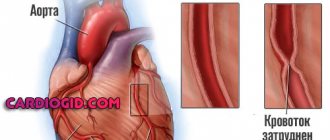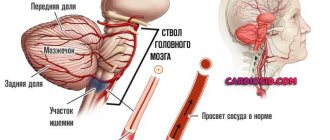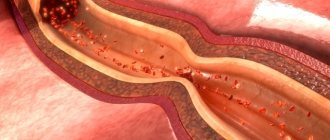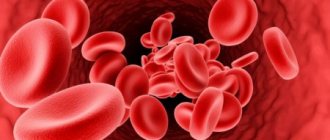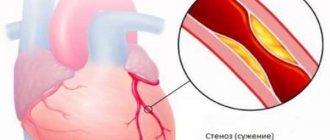Why does pathology occur, how to recognize it
This disease was discovered and fully described in the USA.
Cardiologist M. Prinzmetal did this together with his colleagues. The new disease is called variant Prinzmetal angina. A heart attack causes a sudden spasm of a coronary artery, cutting off blood flow. This type of angina is better known as:
- vasospastic;
- spontaneous.
The risk group mainly includes people from 30 to 50 years old. The problem develops in only 2-5% of people of this age. The disease is classified as a separate group of resting angina pectoris. Treatment methods in this case differ in many ways from more typical, stable angina.
Symptoms of Prinzmetal's angina
Symptoms of the variant form of the disease have recurring periods. Her unpredictable behavior can last up to 60 – 90 days. The main time of occurrence of such attacks is from 23.00 to 7.00 am. The duration of the attack is 3 – 16 minutes. After this, the pain goes away for an indefinite period of time. It is impossible to predict the appearance of the next pain peak. Symptoms of the disease:
- pain in the heart area;
- during an attack of a variant form of the disease, a squeezing feeling occurs in the chest, radiating to the jaw region, the right side of the body (shoulder, arm);
- pain appears in a calm state (inactive);
- frequency of pain every night (almost at the same time);
- duration of pain symptom 3 – 16 minutes;
- the use of nitroglycerin relieves pain;
- in severe form, the disease causes fainting and cardiac arrest.
Due to the unpredictable nature of pain, this pathology has another name - variant angina. It happens that attacks are accompanied by side symptoms, such as:
- blood pressure surges,
- gagging,
- cold sweating
- severe headache in the back of the head,
- abnormal heartbeat rhythm,
- pallor,
- sudden onset of shortness of breath (lack of oxygen).
Important!
If such symptoms appear, urgent assistance and a visit to a specialist are required.
Development mechanism
The mechanism that causes such an intense pathological process is still unknown.
But, nevertheless, there are three hypotheses:
- Improved contractility of coronary vascular smooth muscle due to decreased bioavailability of nitric oxide is caused by a defect in the endothelial enzyme synthetase.
- Acetylcholine. Induces vasoconstriction of vascular smooth muscle cells, it also stimulates endothelial cells to produce nitric oxide (NO). NO then diffuses out of the endothelial cells, stimulating the relaxation of neighboring smooth muscle cells.
- When the endothelium is dysfunctional, acetylcholine stimulation will produce insufficient amounts of nitric oxide. Thus, acetylcholine released by PSNS at rest simply causes contraction of vascular smooth muscle.
- Thromboxane A2. A vasoconstrictor element that is produced by platelets in order to normalize thrombus formation. It also plays a crucial role in the formation of Prinzmetal's angina. Lipoprotein(a) interferes with fibrinolysis by competing with plasminogens. Impaired fibrinolysis causes thrombus formation, which also leads to coronary liquefaction in variant angina.
- Increased levels of alpha-adrenergic receptors affect the activity of the epicardial coronary arteries, which lead to ischemic liquefaction.
In addition to the above-mentioned hypotheses, princemetal of vascular smooth muscles is also associated with vasoconstrictor components - mitogens and sirotinam. The clinical picture will disappear when the chest pain subsides.
If there is no heart disease or some other mild heart disease, but the clinical picture described above appears from time to time, then most likely a Prinzmetal diagnosis will be made by testing the ECG of the heart.
Causes
Chest pain in Prinzmetal's angina is caused by coronary artery spasm, an abnormal or involuntary narrowing of the muscle in the coronary artery. The reason for the formation of angina is that the diameter of the newly formed spasm is much greater than the width of the artery itself.
The result is a blockage in the blood vessel, which restricts the flow of blood and oxygen to the heart, causing pain in the chest area.
According to statistics, Prinzmetal heart disease is very rare, but it is still worth noting that in men the risk of developing this pathological process is several times greater than in women.
The age range of patients, as a rule, is slightly lower than with stable angina, which can develop from 50-55 years. In addition, patients have a lower risk factor for developing heart and vascular diseases. The exception to this group are smokers, who have a high chance of developing coronary artery spasm.
Most people with Princemetal also have coronary artery disease, which is characterized by the presence of atherosclerosis. Prinzmetal's angina alone rarely causes a heart attack.
There is also a very small risk of sudden death (about 2%) in people with arterial spasms.
Prinzmetal's angina is characterized by its suddenness. At rest, a sharp spasm of the blood vessels that supply the heart muscle occurs. As a result of this, our “engine” does not receive useful substances, and most importantly, oxygen. Difficulty in blood circulation, narrowing of the lumen of blood vessels causes chest pain and other signs of cardiac pathology.
The development of an attack is provoked by:
- general hypothermia;
- stress and excessive workload;
- frequent, shallow breathing (provokes hyperventilation).
Any form of unstable condition is characterized by sudden closure of the coronary vessels; in this case, spasm occurs in the large coronary artery and adjacent branches.
Prinzmetal's angina is not characterized by hemodynamic disturbances as a result of arterial stenosis, because it often affects the subepicardial (proximal) part, where the area of the vessel is atherosclerotically changed. But with this pathology, spasm of an unchanged area or the smallest branch of the coronary artery can also occur.
Critical or total obstruction of the artery leads to a sharp decrease in blood supply to the heart muscle. The main reason is vascular damage by atherosclerosis; often its initial stage can provoke pathology.
Additional causes of unstable Prinzmetal angina are:
- hypertension;
- peptic ulcer;
- cholecystitis;
- allergy.
Types of surgery
- Coronary artery bypass surgery (an operation is performed to turn off the contractions of the heart muscles, an artificial respiration apparatus is used, as well as blood circulation. It is carried out with the aim of creating a new bloodstream to supply the area of the myocardium affected by ischemia, this eliminates the development of necrosis).
- Stenting (used to increase the lumen of arteries damaged as a result of stenosis. The operation is performed by introducing a stent through the veins using a catheter. The procedure is controlled by x-rays. General anesthesia is used).
- Angioplasty (used to normalize blood flow in the area of vascular narrowing by balloon dilation).
Risk factors for developing the disease
There are many reasons that contribute to the development of a disease such as spontaneous angina, let’s consider a few of the most basic:
- Hypothermia (not the main cause, but can provoke an attack).
- Atherosclerotic damage to the blood vessels of the heart (the main cause of the development of this disease). This happens due to blockage of blood vessels with cholesterol, which provokes their stenosis, and, accordingly, an attack of Prinzmetal’s angina. This type of angina occurs in more than half of people suffering from atherosclerosis.
- The next factor that can provoke such attacks is smoking. This is not the cause of the disease, but is a serious risk factor.
- Drinking alcoholic beverages.
- Hypodynamic lifestyle (often associated with sedentary work).
- Exposure to frequent stress.
- Failure to follow proper nutrition rules.
Therapeutic measures and prevention
Due to the severity of the disease and the high risk of complications, treatment of Prinzmetal's angina should be carried out in an inpatient setting. Drug therapy involves the following groups of drugs:
- calcium channel blockers (Nifedipine, Amlodipine, Diltiazem, Verapamil);
- prolonged forms of nitrates (Isosorbide dinitrate, Molsidomine, Nicoraldine);
- antiplatelet agents (Aspirin).
Principles of treatment
If emergency care is necessary for developed coronary spasm, pain relief is indicated. For this purpose:
- Fentanyl with Droperidol or Promedol.
- Sublingual nitroglycerin up to 6-8 mg/hour.
- Phenigidine (Nifedipine) – 10-20 mg sublingually.
If there is no effect or if an attack occurs for the first time, urgent hospitalization in the intensive care unit.
Individual prevention of spastic conditions in patients with the vasoplastic form of this disease includes:
- to give up smoking;
- avoiding known attack triggers: strong emotional shocks, hypothermia, hyperventilation, morning physical activity;
- avoidance of vasoconstrictor medications;
- general recommendations for all conditions associated with ischemic heart disease: control of weight, cholesterol levels, exclusion of a sedentary lifestyle, etc.
Symptoms
Symptoms of Prinzmetal's angina may last for several months and then disappear completely for several weeks.
Prinzmetal's vasospastic angina has characteristic symptoms:
- severe pain in the chest (can be localized in the upper limbs, shoulder girdle and head);
- “squeezing” pain in the chest;
- sweating;
- bradycardia (slow heartbeat);
- tachycardia (strong heartbeat due to pain or sudden awakening);
- hypotension (low blood pressure);
- dyspnea;
- weakness;
- dizziness;
- fear of death.
There are a number of characteristic symptoms that can be used to determine that a person has this particular disease.
Here are the main symptoms:
- sharp, very severe pain early in the morning during sleep, or when a person is at rest, mainly in the chest area;
- manifestation of hypotension and tachycardia;
- on the electrocardiogram in the ST segment there is a rise or depression - the picture is approximately similar to that of myocardial infarction;
- pain is accompanied by sweat, it begins to be unbearable;
- the duration of attacks of pain is from five to fifteen minutes, the intervals between them can vary from two to fifteen minutes, although sometimes the attacks are single;
- autonomic disorders;
- headache, nausea, pale skin, fainting and changes in blood pressure before the attack.
If these symptoms are present in a person, then further diagnostics are necessary to determine whether this pathology is manifested in him or whether the cause is something else. You cannot delay diagnosis, otherwise the likelihood of the situation worsening may increase significantly.
A distinctive feature of the manifestation of symptoms of variant angina are attacks at rest and at approximately the same time of day, often late at night or early in the morning.
Attacks of this type of angina are characterized by the sudden development of pain. The pain is pressing in nature, and there may be a burning sensation and cutting pain. Another specific symptom is profuse sweating during pain. Pain can radiate to the shoulder, arm, shoulder blade, neck and jaw on the left side.
Symptoms of pathology
As a rule, attacks occur at rest, at night or in the morning. Pain may occur with moderate physical activity.
Clinically, an attack is characterized by:
- sudden pain in the heart;
- intense sweating;
- decrease or increase in pressure;
- nausea and pallor;
- headache;
- fainting state.
Typically, an attack lasts from 5 to 15 minutes. It is quite difficult for the patient to tolerate and is difficult to stop. In some cases, the attacks are serial. Their symptoms include frequent recurrence. Sometimes the attacks come one after another. In this form, the disease requires urgent hospitalization and comprehensive treatment in a hospital under the constant supervision of specialists.
Complications of the pathology are also dangerous.
These include:
- life-threatening arrhythmia;
- extensive myocardial infarction;
- cardiac aneurysm;
- chronic heart failure.
Their main symptom is severe pain in the heart.
If you do not consult a doctor in time and do not eliminate the causes of the attacks, sudden coronary death may occur.
Diagnostics
Prinzmetal's angina occurs when an area within one of the main coronary arteries suddenly spasms, temporarily cutting off the blood flow to the heart muscle supplied by that artery.
During this process, the ECG shows elevations in the "ST segment". The same changes are often found with heart attacks. Nitrates usually relieve the spasm very quickly, returning the coronary arteries back to normal.
When diagnosing, the doctor tries to find out:
- Does the patient complain of characteristic pain in the chest area?
- Are there any changes in the ECG?
Diagnostic testing may include 24-hour ECG monitoring over several weeks or stress testing.
Sometimes cardiac catheterization with "provocative testing" is simply necessary to make the diagnosis because Prinzmetal's angina is caused by coronary artery spasm rather than a fixed blockage of the artery.
Catheterization usually shows "normal" coronary arteries. In addition, making a correct diagnosis may require evidence that the coronary artery spasm may have been triggered by other factors.
Just two types of “provocations” are often used to try to induce coronary artery spasm—hyperventilation and the use of acetylcholine.
Hyperventilation testing is a non-invasive test. Usually performed early in the morning, when a cramp is more likely to occur. With a hyperventilation test, the patient is instructed to breathe deeply and quickly for a full six minutes. This test is especially useful for people who have frequent attacks of severe Prinzmetal angina.
Testing with acetylcholine or Ergonovine is performed during cardiac catheterization. This type of examination provides an accurate diagnosis than hyperventilation.
One of these drugs is given intravenously (ergonovine) or directly into the coronary artery (acetylcholine). In patients, this manipulation often causes the same localized spasm of the coronary artery as in the normal state.
It can also be visualized during the catheterization procedure.
Currently, testing with acetylcholine is considered safer than testing with Ergonovine. In addition, it is also one of the most preferred invasive challenge tests.
The disease is determined using an ECG during an ongoing attack. On the electrocardiogram, the specialist sees whether the ST segment is elevated. Usually it is raised during a heart attack, but in this case the raised position lasts about a month, and with angina at rest - only 20 minutes.
If the ECG is not enough, then diagnosis is carried out by other methods: cold or ischemic test, hyperventilation tests with acetylcholine and ergometrine.
To check what kind of physical activity the patient is capable of, studies are carried out with the load on the body. Spontaneous angina may require another test to confirm the diagnosis (coronography).
After the diagnosis is made, the patient is prescribed treatment. As a rule, the patient is hospitalized. At the initial stage, the disease is treated with medication.
https://www.youtube.com/watch?v=ldOaanggqrk
Painful attacks, which are so common with this type of angina, are relieved with nitroglycerin.
In the future, the doctor prescribes long-acting nitrates. The coronary arteries are dilated with the help of special drugs - potassium antagonists. But you should remember that all prescriptions are made only by the attending doctor.
The treatment takes place throughout the entire course. If you interrupt it, the negative consequences will not be long in coming: the number of attacks will increase, the symptoms of the disease will worsen, and the risk of developing a heart attack will greatly increase. Therefore, it is necessary to take medications strictly on schedule according to medical prescriptions.
If the patient has severe atherosclerosis, therapeutic measures may not be enough. In this case, the patient may be prescribed surgical treatment, for example, vascular stenting, bypass surgery, and others.
Folk remedies can be used to relieve a pain attack, but not for full treatment. You can use the following tools and methods:
- pepper plaster, mustard powder will reduce pain in the heart if placed on the calves;
- menthol pharmaceutical lozenges for resorption will speed up the passage of pain;
- fir oil rubbed into the chest (in the area of the heart) relieves an attack of the disease;
- Massaging the little finger on the left hand during an attack can relieve pain.
All procedures can be performed only after consultation with a doctor.
The main difficulty of diagnosis is the suddenness and short duration of attacks. Signs of the disease appear exclusively at rest. Prinzmetal's angina, the symptoms and treatment of which only a doctor can determine, is difficult to diagnose. Because of this, during a comprehensive examination, not only the clinical picture is taken into account.
First of all, pathological processes that provoke oxygen starvation of the heart muscle are identified. For this purpose, the following examination methods are used:
- ECG at rest;
- echocardiography;
- Coronography (performed to detect painful spasm);
- cold test;
- bicycle ergometer study (carried out with extreme caution due to the threat of lethal arrhythmia);
- stress test (treadmill test).
With a problem such as Prinzmetal's angina, the ECG during an attack can show changes similar to myocardial infarction. The difficulty is that the characteristic signs persist for 2-3 minutes. As the pain subsides, the heart muscle gradually recovers. 24-hour cardiometry is used, which can only be performed in a hospital.
Prinzmetal's angina on the ECG is manifested by the following changes:
- raising the RS-T segment above the isoelectric line;
- increase in R wave;
- expansion of the QRS complex;
- the appearance of a pathological Q wave.
All of these methods are standard for ischemia.
The main method of diagnosing the disease is to conduct an ECG during an attack. If the ST segment on the electrocardiogram is elevated, then this disease is usually diagnosed.
The main difference from myocardial infarction is that in a heart attack, the specified segment is in an elevated state for approximately a month, and in similar angina, as a rule, no more than twenty minutes.
Rest angina of any form, as well as vasospastic unstable angina, should be registered not only on the basis of clinical signs, but the general pathogenetic picture, when the doctor finds out all the possible reasons that provoked oxygen starvation of the myocardium and vasospasm.
The best diagnostic criterion is an ECG. But in the absence of an attack, it does not always provide the correct information, therefore, to clarify and make a diagnosis, a patient with suspected Prinzmetal angina must be hospitalized in the intensive care unit, where all the necessary examinations will be carried out and treatment will be prescribed.
The classic version when examined using an ECG is characterized by:
- raising the RS-T segment above the isoline through a high T wave during the period of anginal pain, which is characteristic of ischemia of a transmural infarction;
- the appearance of a pathological U wave, when it becomes pointed or inverted, which indicates a disturbance in electrical conductivity and heart rhythm;
- enlargement and widening of the R wave;
- widening of the ventricular QRS complex.
ECG readings may recover after anginal pain subsides, but some will continue to indicate heart rhythm disturbances even between attacks.
Making a diagnosis and prescribing effective treatment is possible only by a specialist after assessing the patient’s health status and the results of comprehensive diagnostics.
Important nuances
If you first suspect Prinzmetal's angina, you should immediately consult a doctor. As a rule, the patient is hospitalized without delay. When treating the disease, they try to eliminate ischemia and eliminate vasospasm and arrhythmia. Otherwise, there is a high probability of death of the patient.
If drug treatment measures have been prescribed, the patient must carefully and strictly follow the doctor's recommendations. If the patient has taken large doses of drugs, especially nitrates, calcium channel blockers, abrupt cessation of such therapy leads to withdrawal syndrome. In such a situation, the frequency of attacks doubles and leads to a very severe heart attack.
In some patients, Prinzmetal's angina is diagnosed against the background of complex atherosclerosis. In this case, surgical intervention is permissible. As a rule, angioplasty or bypass surgery is performed.
Treatment
During the treatment of Prinzmetal's angina, drug therapy is carried out, in particular long-acting nitrates and calcium channel blockers. Each of which stimulates the dilation or opening of blood vessels and improves blood circulation of oxygen flow to the heart muscle.
Calcium channel blockers are usually prescribed first. If you continue to experience chest pain, a different class of calcium channel blocker or a long-acting nitrate may be prescribed.
Nitroglycerin is used when a spasm is experienced to stop it, thereby relieving the pain. It is not taken as a preventative medicine. Nitroglycerin is usually given as a spray that is used in the mouth or as a tablet that must be dissolved under the tongue
Modification of risk factors is also important because most people with Prinzmetal have cardiovascular disease and are therefore at risk for a heart attack.
It is also necessary to give up bad habits. By reducing your risk factors, you reduce your risk of developing atherosclerosis. In addition, patients diagnosed with Prinzmetal's angina should avoid exposure to cold and stressful situations, as they can cause seizures.
It is not so easy even for experienced doctors to recognize the disease based only on the symptoms listed by the patient. Many pathologies have identical symptoms, so it is possible to identify a specific disease only through diagnostics.
Currently, medicine has in its arsenal a variety of diagnostic tools, using which, in most cases, doctors can accurately determine which disease provokes a deterioration in the patient’s health.
Prinzmetal's angina is recognized by diagnosticians, however, unfortunately, at present there is no equipment that could immediately and absolutely accurately indicate the development of this disease.
For this reason, patients are often offered to undergo several different diagnostics, after comprehensively analyzing the results of which, doctors can confidently establish a diagnosis. Symptoms and treatment are closely interrelated, as doctors develop a scheme of care that involves symptomatic therapy and eliminating the root cause.
In addition to collecting anamnesis and patient complaints, the doctor needs the results of an instrumental diagnostic examination. For this reason, before starting the main treatment, the patient is sent to undergo:
- electrocardiograms;
- long-term Holter ECG monitoring;
- coronary angiography;
- functional load tests;
- functional tests.
Having studied the results of the diagnostics in detail, doctors move on to creating a treatment regimen.
Medical assistance
Variant angina can only be treated in a hospital setting, where appropriate diagnostics will not only be carried out, but treatment will be prescribed that can prevent the development of complications.
Therapeutic therapy is aimed at:
- elimination of coronary artery spasm and ischemia;
- reducing the likelihood of developing acute myocardial infarction and sudden coronary death.
For this purpose, the patient is immobilized and placed on bed rest. Liquid intake and high-calorie foods are also limited. The patient should eat small portions throughout the day so as not to overload the body.
| Intravenous administration of nitroglycerin | To dilate blood vessels and relieve attacks. |
| Long acting nitrates | To relieve pain symptoms. |
| Calcium antagonists | They also dilate blood vessels. |
| Antiplatelet agents and anticoagulants | Reduce blood clotting and prevent the formation of repeated blood clots. |
| Beta blockers | Dilate blood vessels and reduce heart rate. |
Therapy is carried out under the supervision of a doctor, because an overdose of cardiac drugs can lead to irreversible consequences. For example, due to the abrupt withdrawal of calcium antagonists or nitrates, which were taken in large quantities, the frequency of painful attacks increases by 50%. In addition, acute myocardial infarction may develop.
| Coronary artery bypass grafting |
|
| Stenting |
|
Treatment should take place in a hospital setting; its essence is to relieve spasm and prevent cardiac ischemia. But also, under the supervision of medical personnel, it becomes possible to minimize the likelihood of developing myocardial infarction, as well as coronary death.
To relieve pain during an attack, it is effective to use nitroglycerin (by resorption under the tongue). The next step is to take medications belonging to the group of nitrates that have a prolonged effect. In combination, drugs from the group of calcium antagonists can be prescribed for effective treatment.
They contribute to the expansion of the coronary arteries and collateral arteries (verapamil, nifedipine). In cases of coronary artery obstruction, b-blockers are prescribed. Often, people with this disease need to use antiplatelet agents (thromboass, acetylsalicylic acid).
A sharp refusal to take drugs from the nitrate group can develop a withdrawal syndrome, characterized by an increase in the number of attacks or provoking myocardial infarction.
Drug treatment is not the only way to get rid of the disease in question. Surgical treatment is usually used in severe cases of the disease, usually combined with severe damage to the coronary vessels from atherosclerotic plaques.
So what should we do?
Once Prinzmetal's angina has been diagnosed, treatment becomes challenging. Medication measures show the greatest effectiveness. In this case, they resort to several groups of drugs.
First of all, the patient should have short-acting, quick-acting medications on hand. As a rule, this is a nitroglycerin spray or tablets. It is necessary to take the medication as soon as the attack begins so that the symptoms subside. As a preventive measure, it is permissible to use drugs based on nitroglycerin, but acting for a long period of time. These include:
- "Kardiket";
- "Nitrosorbide".
Consequences
Although in general the prognosis of patients with Prinzmetal's angina is quite good, this does not mean that the disease cannot affect their well-being in the future. The disease process can cause dangerous and potentially fatal cardiac arrhythmias, especially ventricular fibrillation.
Heart attacks uncharacteristic of Prinzmetal's angina can actually occur, causing irreversible damage to the heart muscle. Adequate treatment of angina significantly reduces the risk of developing such complications. With effective treatment, people with this disease can lead full and healthy lives.
Although this pathology can lead to a heart attack, the likelihood of this is quite small, because the spasms are not long enough for this kind of consequences.
Sometimes, due to such angina, the electrical function of the heart can be impaired, which is very dangerous. This can lead to heart rhythm disturbances, some of which, such as ventricular tachycardia, can be fatal if not caught early.
The likelihood of a negative outcome is extremely low in the absence of obstructive lesions of the coronary arteries. If Prinzmetal angina continues for a long time, attacks are frequent and severe, then the probability of death can increase to twenty-five percent.
The risk of negative consequences directly depends on whether coronary obstruction is present, as well as how frequent, prolonged and severe the patient’s attacks are.
Very often, the prognosis of the clinical condition is unfavorable, because acute coronary insufficiency may develop, which will lead to a large heart attack, concomitant pathologies of the cardiovascular system, brain, lungs and death of the patient.
The degree of complications depends on the duration and frequency of attacks and damage to the coronary arteries.
If there is no obstructive vascular damage, coronary death develops quite rarely; in the opposite cases, after the onset of pathology or within six months, 10% of patients die.
In 20% of patients, even after developing myocardial infarction, remission occurs, but the pathology can return at any time. Therefore, patients who have experienced spontaneous unstable angina should be registered with a cardiologist at the dispensary department.
Possible complications
It must be remembered that variant diagnosed Prinzmetal angina can cause serious deviations, in particular, the patient’s life may be threatened.
Conditions such as:
- extensive cardiac infarction;
- aneurysm;
- chronic heart failure;
- vegetative-vascular dystonia, abbreviated as VSD;
- sudden coronary death.
It is impossible to predict in advance whether complications will arise in a given situation. Their appearance depends mainly on the duration of the attack and the frequency of its occurrence.
Prevention
Prevention of this disease is simple and clear. It is necessary to exclude some of the reasons that caused it (primarily smoking). If a person does not smoke, then it is worth limiting visits to those places where tobacco use is permitted.
Movement is life. This rule saves you from many diseases. Heart problems are also one of these. If a person moves more, it has a good effect on the heart and blood vessels.
Food should not be high in calories. It is better to exclude products with animal fats from the diet. Alcohol should be prohibited.
A full, healthy sleep of at least 8 hours is necessary. Before him, evening walks in the fresh air are desirable.
A person of any age can follow these simple rules to avoid health problems.
The long-term prognosis after treatment of Prinzmetal's angina is quite favorable. Sometimes remission occurs, lasting for years.
Negative consequences are also possible. This is a myocardial infarction in patients who have suffered from angina for a long time.
To monitor their condition, each patient is registered with a cardiologist. Constant medical supervision will help avoid worsening the situation.
Even with one attack of resting angina, constant monitoring by a cardiologist is necessary in the future.
As with other forms of progressive heart failure, prevention includes:
- clinical observation by a cardiologist;
- low-calorie diet (implies limitation of refractory animal fats, sour cream, butter, hard cheese, cream, fatty meat);
- complete cessation of alcohol and smoking;
- moderate physical activity (hiking, swimming, physical therapy);
- sleep at least 8 hours a day;
- limiting emotional stress (the patient should avoid stress and nervous tension).
Generally, the long-term prognosis is positive. Sometimes spontaneous remission may occur and last for years.
Among the negative consequences, myocardial infarction may occur in patients who have had this disease for a long time. Since this pathology is unstable, every person who suffers from it must definitely be monitored by a cardiologist in order to control the situation and avoid its aggravation.
In addition, to prevent the situation from recurring, it is necessary to stop smoking, normalize the tone of the ANS and get rid of hyperlipidemia, if any. To prevent myocardial infarction in the presence of this problem, it is recommended to take acetylsalicylic acid on an ongoing basis.
You can find out more detailed information about preventative procedures from your doctor.
Activities that will help prolong the patient’s life and improve its quality are primarily aimed at solving the main problem – atherosclerosis. For this purpose, it is recommended to give up bad habits, engage in moderate physical activity, get proper rest, avoid stress, pressure surges, and everything that can cause spasm of the coronary vessels.
It is necessary to switch to a healthy, nutritious diet, which will exclude foods that increase cholesterol levels.
To reduce cholesterol and prevent the development of various diseases, including unstable angina, it is recommended to use alternative medicine recipes. With their help, you can successfully cleanse blood vessels of fatty deposits and strengthen the functioning of the cardiovascular system.
The goal of prevention will be to prevent atherosclerosis, the main cause that can cause Prinzmetal angina.
Principles that exclude the possibility of disease:
- to give up smoking;
- complete cessation of drinking alcoholic beverages;
- do not overstrain the body;
- avoid frequent stressful situations;
- exercise;
- to live an active lifestyle;
- spend more time in the fresh air;
- walking at a relaxed pace;
- Try to stick to proper nutrition and avoid eating foods that cause an increase in cholesterol levels in the body.
Treatment, prognosis, prevention
If there is a suspicion of variant angina, the patient should be hospitalized. Treatment aims to eliminate vasospasm and myocardial ischemia, minimize the occurrence of arrhythmia, and eliminate the likelihood of acute heart attack and sudden death.
To eliminate attacks of variant angina, sublingual nitroglycerin is prescribed followed by prolonged-release nitrate medications. In parallel with them or instead of them, calcium antagonists are prescribed, such as diltiazem, nifedipine or verapamil. Their action is to dilate the coronary arteries and other vessels. If obstructive pathologies of the coronary arteries occur, b-blockers are added. The use of antiplatelet agents in the form of acetylsalicylic acid in small doses is also indicated.
The patient must remember that abrupt cessation of taking large doses of nitrates and calcium antagonists can cause withdrawal syndrome, in which the frequency of anginal attacks increases by 50% or more and can lead to the development of myocardial infarction.
If Prinzmetal's angina is combined with a severe form of atherosclerosis of the coronary vessels, surgical treatment in the form of coronary artery bypass grafting or angioplasty of the coronary arteries can be performed.
The risk of complications directly depends on the presence and degree of damage to the coronary arteries, the duration of attacks, their frequency and severity. If the coronary arteries are not damaged, the risk of sudden death is low (about 0.5% per year). If attacks are frequent, prolonged and severe, the probability of death is 20-25%.
Since variant angina is one of the types of coronary insufficiency, the patient suffering from it must be registered with a cardiologist. Measures to prevent the disease include combating excess cholesterol levels in the blood, quitting smoking and normalizing the tone of the autonomic nervous system (ANS).
Additional Information
Vasospastic angina (Prinzmetal's angina) is variant, spontaneous, caused by spasm of the coronary arteries. This form of angina is classified as unstable, as it can occur at any time and cannot be predicted. In stable angina, pain occurs predictably with exercise.
Variant angina occurs in patients aged 30 to 50 years and is one of the forms of unstable angina. Its main difference from angina pectoris, which occurs due to damage to blood vessels by atherosclerotic plaques, is a strong spasm of the heart vessels. In this case, spasm is observed in the coronary arteries, which are minimally affected by atherosclerosis.
Variant Prinzmetal angina occurs due to spasms of the coronary artery.
Impaired contraction of vascular smooth muscle leads to its narrowing and reduced blood flow to the heart. In some cases, the spasm cannot be stopped and sudden death of the patient occurs.
Factors that can cause an attack: stress, windy weather or cold season. Angina is called variant angina because its pain is unpredictable and can occur unexpectedly and does not depend on physical activity. The patient can be at rest, sleeping, but an attack still occurs.
The main provoking factor of Prinzmetal's angina is atherosclerosis, which may be at an early stage.
Chronic smoking and diseases have a great influence: high blood pressure, cholecystitis, stomach ulcers, allergic reactions and others, which are characterized by an imbalance in the state of the autonomic nervous system and vascular spasms.
An attack of spontaneous angina can be caused by hypothermia, emotional stress, hyperventilation, but more often it occurs for no particular reason. The main symptom of Prinzmetal's angina is attacks at rest, in the absence of negative factors, or when performing light physical activity without overexertion.
Prognosis and complications
The prognosis is closely related to the degree of coronary heart disease and timely diagnosis. People who had an ST-elevated ECG were 3 times more likely to die. Variant angina increases the risk of developing cardiac arrhythmia, a small but significant risk of sudden cardiac death.
Sudden cardiac death occurs most often in people who have spasms in multiple arteries and experience arrhythmias.
The favorable prognosis for the treatment of spontaneous angina depends on the frequency and severity of attacks, as well as concomitant diseases. Timely treatment and compliance with preventive measures reduces the risk of myocardial infarction. The absence of coronary artery obstruction increases the possibility of cure.


